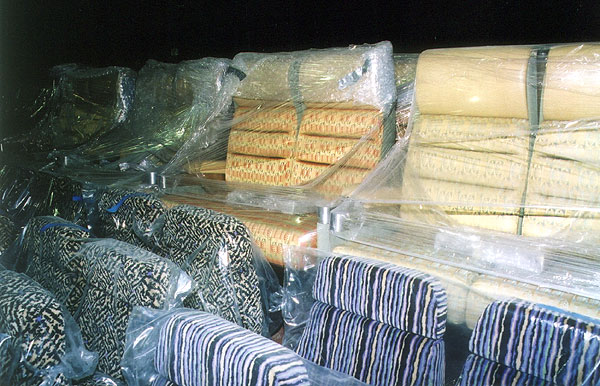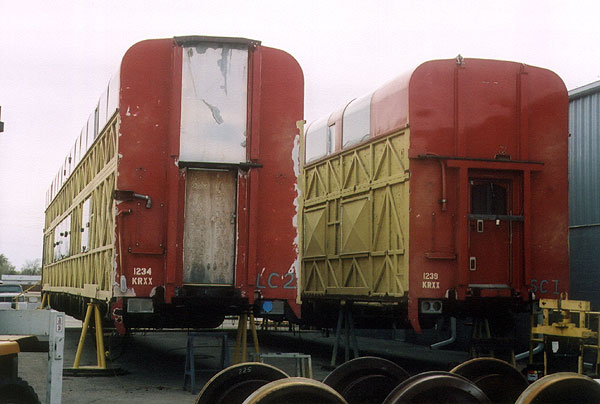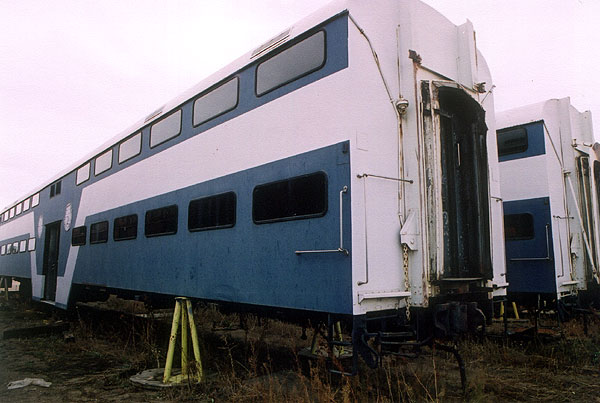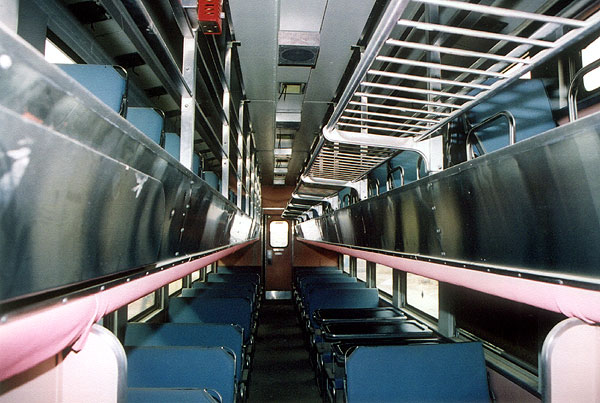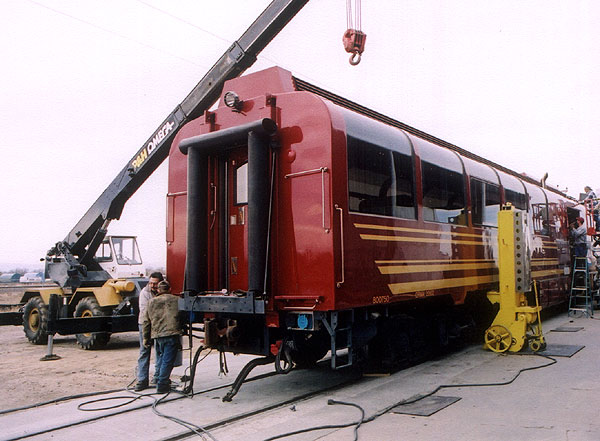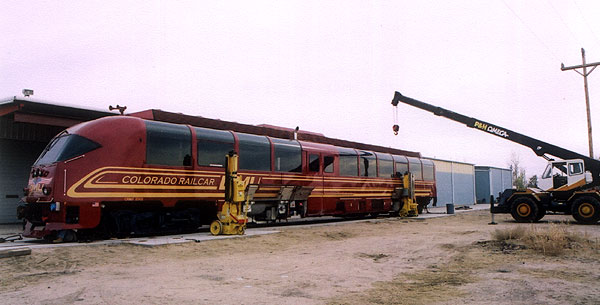This website has been archived from TrainWeb.org/ultradomes to TrainWeb.US/ultradomes.
|
A tour of the Colorado Railcar shop While in Denver on business, I took advantage of my location to spend a few hours (and several rolls of film) at Colorado Railcar's Ft. Lupton shops. The results were quite interesting, and several of the overall photos are shared in this gallery. You will also find photos in several other galleries that are linked throughout. Colorado Railcar Manufacturing is a private business, and has no obligation to open its doors when any Joe off the street comes knocking. So I felt a great deal of gratitude for the warm reception I received when I arrived, and for the time that several CRM staffers took to answer my questions and escort me around the facility. While a large number of people are to be thanked, I'd especially like to give my thanks to CRM VP Tom Janaky, who helped arrange the tour, and Steve Peck, who took time out of a busy day to show me around.
I had looked at several maps before flying in, and had a good feel for the location of the shop. As we closed on Denver International Airport, the Front Range faded into the distance and I saw what I figured was the shop, and snapped a quick frame shortly before landing on the outside chance that I was right. Turns out I lucked out and got the shop. From the outside, Colorado Railcar is a nondescript, squarish warehouse (at center of frame, identified by the arrow.) It doesn't stand out like you'd expect the birthplace for some of the most luxurious railcars on the planet would. Only a small sign by the road identifies the location to passers by.
I couldn't have picked a better time to visit CRM's shops. My Nov., 2003 visit timed out nicely with the construction of several cars, including (from right to left) Rocky Mountaineer 9523, Holland America 1056, 1055, 1057 and 1054. All five cars were in various states of construction, affording a very interesting view of the later part of the process. It will be interesting if I am ever to get back in the future to see the difference in complexion that the shop takes on when it moves into regular DMU production. A look at the manufacturing process can be seen by following this link. We also took time to tour the inside of RMR 9523, and HALX 1055 while they were under construction. Amazingly enough, the five cars only took up a fraction of the expansive shop, which also has sections dedicated to initial layup, truck rebuilding, parts fabrication and other use, as well as generous office space for the shop staff. A separate administrative office is kept in nearby Evergreen, CO.
Two different styles of seats in four different samples of decor. The top seats are destined for RMR 9523, while the other seats will be used in the Holland America cars. Row after row of the sealed up seats were staged along one wall of the complex awaiting installation in the railcars once they near completion. At the time of the visit, none of the cars had seats installed.
Outside, remnants of former projects, parts and displays sit side by side, a reflection of the company's past and a tantalizing nod to its future. Perhaps the most graphic description of the latter is the pair of demo cars that sit right outside the shop. Mezzanine lounge car LC-2 and sleeper car SC-1 are partially decorated to show some other applications of the ultradome cars. They are so interesting that they merited their own photo gallery, which I hope you'll enjoy.
Out behind the shop, there are several other cars that have been assembled for various purposes. The two ex-Chicago & Northwestern commuter cars were purchased primarily for their trucks, while the sleeper cars were purchased for another project. At the left is the now famous hot tub car that was in the process of being built for the Marlboro Unlimited. It is a single level car, and may be refitted some day as a diner.
Ultradomes in waiting? Distant cousins? While the first four cars were built from bilevels like these, It's a common misconception, that they still are today. We've hopefully put that to rest in the new manufacturing section. So what exactly are these ex-CNW bilevels doing behind the CRM shop? Trading in their trucks and other parts. That's about it. As an aside, I'm kind of interested in these cars, as there was a long line of them parked at the Port of Pasco industrial complex where I used to live, and they were painted the exact same way. I recall one of them being shipped out a number of years ago, but I don't recall exactly where. I think it might have been here. There are still three cars — all painted the same way — in Pasco, and several more in Alaska. Anybody know anything about this all?
Gallery seating inside the car shown above. It hardly matches the ultradome style. But then the car was built for one purpose, and that was moving large numbers of commuters back and forth as efficiently as possible. And that it accomplishes. I did find the luggage rack in the center quite interesting. It's hard to imagine that the first four ultradomes started out that way.
CRM's well-traveled DMU demonstrator was also in the shop for some running maintenance before hitting the road again. While the cars inside were getting their fair share of attention, the DMU was the clear star of the show, meriting a frenzy of activity from all sides. While luxury railcar building is Colorado Railcar's bread and butter, the actual market for such cars is quite limited. Seeking to meet another need, CRM set out a few years ago to design a commuter vehicle that would meet the stringent new FRA safety requirements, and steer the company into another field of operation. The DMU is the result of that effort, and has spent most of its career traveling from city to city on a rigorous demonstration campaign that has taken it from the tip of the Florida panhandle to the remote rail corridors of Alaska. While the prototype had yet to yield an actual order at the time of our visit, there were several possibilities which would hopefully reach fruition soon.
Colorado Railcar has invested literally millions of dollars in the design and development of this prototype, and hasn't wasted any chance to get the car before the public eye. In its first two seasons, it has done demonstration duties in nearly every major metropolitan area in the United States, and even paid a visit or two to Canada. And with that rigorous demo schedule has come the need for a little touching up, and a few modifications. I was very fortunate to conclude my tour of the facility with a closer look at the DMU prototype. It will be interesting to see what changes have taken place at the facility when and if I am fortunate enough to return. But in the mean time, I owe a debt of gratitude to the employees of Colorado Railcar for hosting me for an afternoon at the facility. I hope these tours help give a little flavor of what it's like at the birthplace of the world's most luxurious dome cars. In August, 2004, I toured the shop again, and composed a second tour page with photos from that visit. You can find that page by following this link. Enjoy! Use the back button on your browser to return to the car roster page that you came from. |
Return to the home page
Roster
/ History / Ultra
Domes / Single Level / Commuter
Operators
/ Photos & Features / News
& Updates / Links













